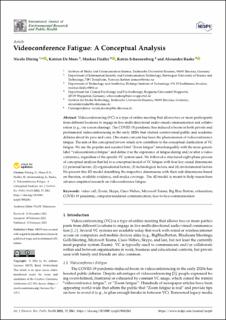| dc.contributor.author | Nicola, Döring | |
| dc.contributor.author | De Moor, Katrien | |
| dc.contributor.author | Fiedler, Markus | |
| dc.contributor.author | Schoenenberg, Katrin | |
| dc.contributor.author | Raake, Alexander | |
| dc.date.accessioned | 2022-04-26T08:22:01Z | |
| dc.date.available | 2022-04-26T08:22:01Z | |
| dc.date.created | 2022-02-15T21:52:55Z | |
| dc.date.issued | 2022 | |
| dc.identifier.issn | 1661-7827 | |
| dc.identifier.uri | https://hdl.handle.net/11250/2992728 | |
| dc.description.abstract | Videoconferencing (VC) is a type of online meeting that allows two or more participants from different locations to engage in live multi-directional audio-visual communication and collaboration (e.g., via screen sharing). The COVID-19 pandemic has induced a boom in both private and professional videoconferencing in the early 2020s that elicited controversial public and academic debates about its pros and cons. One main concern has been the phenomenon of videoconference fatigue. The aim of this conceptual review article is to contribute to the conceptual clarification of VC fatigue. We use the popular and succinct label “Zoom fatigue” interchangeably with the more generic label “videoconference fatigue” and define it as the experience of fatigue during and/or after a videoconference, regardless of the specific VC system used. We followed a structured eight-phase process of conceptual analysis that led to a conceptual model of VC fatigue with four key causal dimensions: (1) personal factors, (2) organizational factors, (3) technological factors, and (4) environmental factors. We present this 4D model describing the respective dimensions with their sub-dimensions based on theories, available evidence, and media coverage. The 4D-model is meant to help researchers advance empirical research on videoconference fatigue. | en_US |
| dc.language.iso | eng | en_US |
| dc.publisher | Elsevier | en_US |
| dc.relation.uri | https://www.mdpi.com/1660-4601/19/4/2061/htm | |
| dc.rights | Navngivelse 4.0 Internasjonal | * |
| dc.rights.uri | http://creativecommons.org/licenses/by/4.0/deed.no | * |
| dc.title | Videoconference Fatigue: A Conceptual Analysis | en_US |
| dc.type | Peer reviewed | en_US |
| dc.type | Journal article | en_US |
| dc.description.version | publishedVersion | en_US |
| dc.source.volume | 19 | en_US |
| dc.source.journal | International Journal of Environmental Research and Public Health (IJERPH) | en_US |
| dc.source.issue | 4 | en_US |
| dc.identifier.doi | 10.3390/ijerph19042061 | |
| dc.identifier.cristin | 2002069 | |
| cristin.ispublished | true | |
| cristin.fulltext | original | |
| cristin.qualitycode | 1 | |

